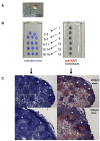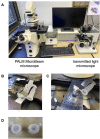Protocol to Isolate Germinal Centers by Laser Microdissection
- PMID: 35799906
- PMCID: PMC9243518
- DOI: 10.21769/BioProtoc.4431
Protocol to Isolate Germinal Centers by Laser Microdissection
Abstract
During adaptive immune responses, germinal centers (GC) appear as transient microstructures, in which antigen-specific B and T cells interact with each other. Because only the antigen-activated B and T cells, such as Plasmablasts or follicular T helper (Tfh) cells, are present in GC, the in depth-analysis of GC is of great interest. To identify the cells that reside within GC, the majority of studies use the expression of specific surface molecules for analysis by flow cytometry. To do so, the tissue has to be disrupted for the preparation of single-cell suspensions. Thereby, the local information regarding neighborhoods of B cells and T cells and their potential interaction is lost. To study GC in vivo within their original microenvironment, we established a protocol for the isolation of GC by laser microdissection. To enable the identification of GC for subsequent transcriptomic analysis, the degradation of mRNA was diminished by using frozen tissues and by establishing a rapid staining protocol. This procedure enables histological and transcriptomic analysis of individual GC even within one lymphoid organ.
Keywords: Cryo-preserved lymphoid structures; Follicular T helper cells; Germinal centers; In vivo analysis; Laser microdissection; Secondary lymphoid organs.
Copyright © The Authors; exclusive licensee Bio-protocol LLC.
Conflict of interest statement
Competing interests The authors indicate no potential conflicts of interest.
Figures




References
-
- Gasteiger G. , Ataide M. and Kastenmüller W. ( 2016 . ). Lymph node- an organ for T-cell activation and pathogen defense . Immunol Rev 271 ( 1 ): 200 - 220 . - PubMed
-
- Kalies K. , Konig P. , Zhang Y. M. , Deierling M. , Barthelmann J. , Stamm C. and Westermann J. ( 2008 . ). Nonoverlapping expression of IL10, IL12p40, and IFNgamma mRNA in the marginal zone and T cell zone of the spleen after antigenic stimulation . J Immunol 180 ( 8 ): 5457 - 5465 . - PubMed
-
- Niebuhr M. , Belde J. , Fahnrich A. , Serge A. , Irla M. , Ellebrecht C. T. , Hammers C. M. , Bieber K. , Westermann J. and Kalies K. ( 2021 . ). Receptor repertoires of murine follicular T helper cells reveal a high clonal overlap in separate lymph nodes in autoimmunity . Elife 10 : e70053 . - PMC - PubMed
LinkOut - more resources
Full Text Sources
Miscellaneous

